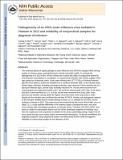Pathogenicity of an H5N1 avian influenza virus isolated in Vietnam in 2012 and reliability of conjunctival samples for diagnosis of infection
Author(s)
Bui, Vuong N.; Dao, Tung D.; Nguyen, Tham T.H.; Nguyen, Lien T.; Bui, Anh N.; Trinh, Dai Q.; Pham, Nga T.; Inui, Kenjiro; Runstadler, Jonathan; Ogawa, Haruko; Nguyen, Khong V.; Imai, Kunitoshi; ... Show more Show less
DownloadRunstadler_Pathogenicity of.pdf (726.4Kb)
PUBLISHER_CC
Publisher with Creative Commons License
Creative Commons Attribution
Terms of use
Metadata
Show full item recordAbstract
The continued spread of highly pathogenic avian influenza virus (HPAIV) subtype H5N1 among poultry in Vietnam poses a potential threat to animals and public health. To evaluate the pathogenicity of a 2012 H5N1 HPAIV isolate and to assess the utility of conjunctival swabs for viral detection and isolation in surveillance, an experimental infection with HPAIV subtype H5N1 was carried out in domestic ducks. Ducks were infected with 10[superscript 7.2] TCID[subscript 50] of A/duck/Vietnam/QB1207/2012 (H5N1), which was isolated from a moribund domestic duck. In the infected ducks, clinical signs of disease, including neurological disorder, were observed. Ducks started to die at 3 days-post-infection (dpi), and the study mortality reached 67%. Viruses were recovered from oropharyngeal and conjunctival swabs until 7 dpi and from cloacal swabs until 4 dpi. In the ducks that died or were sacrificed on 3, 5, or 6 dpi, viruses were recovered from lung, brain, heart, pancreas and intestine, among which the highest virus titers were in the lung, brain or heart. Results of virus titration were confirmed by real-time RT-PCR. Genetic and phylogenetic analysis of the HA gene revealed that the isolate belongs to clade 2.3.2.1 similarly to the H5N1 viruses isolated in Vietnam in 2012. The present study demonstrated that this recent HPAI H5N1 virus of clade 2.3.2.1 could replicate efficiently in the systemic organs, including the brain, and cause severe disease with neurological symptoms in domestic ducks. Therefore, this HPAI H5N1 virus seems to retain the neurotrophic feature and has further developed properties of shedding virus from the oropharynx and conjunctiva in addition to the cloaca, potentially posing a higher risk of virus spread through cross-contact and/or environmental transmission. Continued surveillance and diagnostic programs using conjunctival swabs in the field would further verify the apparent reliability of conjunctival samples for the detection of AIV.
Date issued
2013-11Department
Massachusetts Institute of Technology. Department of Biological EngineeringJournal
Virus Research
Publisher
Elsevier
Citation
Bui, Vuong N., Tung D. Dao, Tham T.H. Nguyen, Lien T. Nguyen, Anh N. Bui, Dai Q. Trinh, Nga T. Pham, et al. “Pathogenicity of an H5N1 Avian Influenza Virus Isolated in Vietnam in 2012 and Reliability of Conjunctival Samples for Diagnosis of Infection.” Virus Research 179 (January 2014): 125–132.
Version: Author's final manuscript
ISSN
01681702